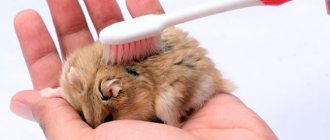Do hamsters get rabies?
For some reason, many are sure that hamsters and rabies are incompatible concepts. Unfortunately, the reality is not so rosy.
Unfortunately, hamsters get rabies. And how! These animals are often carriers of a deadly, incurable disease. In 2011, a family of 4 people in the Ukrainian Zhitomir, in particular, ended up in the hospital. Everyone was bitten by a “harmless” domestic hamster. Fortunately, in that story everything ended well: the head of the family was alarmed by the sudden aggression of a previously phlegmatic pet, and he immediately went to the hospital. And saved four lives.
Remember! That rabies in hamsters is not science fiction. The probability may be small, but it could happen.
Are hamsters carriers of rabies?
In epizootology, a “carrier” refers, rather, to an animal suffering from a chronic form of the disease and having no visible signs of infection. Chronic rabies does occur, but these are unique cases.
Important! Without going into terminology, hamsters (like almost any warm-blooded animal) can carry rabies. They are one of the natural reservoirs of many infectious diseases, including rabies.
Digging a little from the topic: if a person is attacked by a mouse (or rat) and bitten, he should urgently go to the hospital!
A retrospective look at the virus
The infection was first recorded in dogs and described by Democritus back in the 5th century BC, and already in the 1st century AD, the rabies virus was discovered in humans, giving it the definition of hydrophobia. The disease is transmitted easily and quickly from animals to humans through bites. At first, it was recommended to cauterize wounds to prevent infection on the surface of the wound. Only at the end of the 19th century was the first vaccine against the rabies virus developed.
Modern medicine uses this development, combining it with two anti-rabies drugs: serum and immunoglobulin. The doctor injects deep into the wound and injects the substance into the soft tissue around the wound. The high effectiveness of the vaccine depends on the time of seeking help after bites. Accordingly, the sooner a bitten person is vaccinated, the more likely the success of recovery. The situation is similar for pets: a problem noticed in time will allow your pet to be successfully treated.
Just a decade ago, the dangerous virus was considered an incurable disease, and after the first symptoms appeared, hopes for recovery were zero. Innovations in the field of medicine have made it possible to step forward and doctors are happy to record cases of recovery at the symptomatic stage. We cannot say that the disease has been completely defeated; it still remains one of the most dangerous infectious diseases of the body, because out of 37 people, only 5 people were lucky enough to be successfully cured. After being bitten, especially by street or wild animals, do not neglect going to the hospital or veterinary clinic, which can subsequently save the health and life of you and your rodent.
Vaccines and vaccinations against rabies in hamsters - myths and truth
Vaccines and vaccinations against rabies in hamsters - myths and truth about this are so closely intertwined that understanding this issue can be very difficult. Here, for example, is the very fact of vaccination. Are hamsters vaccinated at all?
Vaccination is possible... but in practice it is used extremely rarely. In fact, hamsters are only vaccinated during the creation and testing of new types of biological products. In some cases, vaccines (for example, against rhinopneumonia) were created thanks to the “labor” of home workers alone. In order to prevent the disease in rodents themselves, vaccinations are used in vanishingly rare cases.
Why should you contact the Mama Papa Ya clinic?
The network of family clinics “Mama Papa Ya”, whose branches are located in different districts of Moscow, provides services for the prevention of rabies through vaccination. To get vaccinated, you need to make an appointment with a therapist or pediatrician, and then get an injection there. Advantages of our clinic:
detailed consultation with a specialist before vaccination;
- the opportunity to visit an allergist for relevant diseases;
- various laboratory diagnostics;
- affordable prices and no queues.
For more detailed information, make an appointment with a specialist by phone or on our website.
Reviews
Good clinic, good doctor!
Raisa Vasilievna can clearly and clearly explain what the problem is. If something is wrong, she speaks about everything directly, not in a veiled way, as other doctors sometimes do. I don’t regret that I ended up with her. Anna
I would like to express my gratitude to the staff of the clinic: Mom, Dad, and me. The clinic has a very friendly atmosphere, a very friendly and cheerful team and highly qualified specialists. Thank you very much! I wish your clinic prosperity.
Anonymous user
Today I had a mole removed on my face from dermatologist I.A. Kodareva. The doctor is very neat! Correct! Thanks a lot! Administrator Yulia Borshchevskaya is friendly and accurately fulfills her duties.
Belova E.M.
Today I was treated at the clinic, I was satisfied with the staff, as well as the gynecologist. Everyone treats patients with respect and attention. Many thanks to them and continued prosperity.
Anonymous user
The Mama Papa Ya clinic in Lyubertsy is very good. The team is friendly and responsive. I recommend this clinic to all my friends. Thanks to all doctors and administrators. I wish the clinic prosperity and many adequate clients.
Iratyev V.V.
We visited the “Mama Papa Ya” Clinic with our child. A consultation with a pediatric cardiologist was needed. I liked the clinic. Good service, doctors. There was no queue, everything was the same price.
Evgeniya
I liked the first visit. They examined me carefully, prescribed additional examinations, and gave me good recommendations. I will continue treatment further; I liked the conditions at the clinic.
Christina
The doctor carefully examined my husband, prescribed an ECG and made a preliminary diagnosis. She gave recommendations on our situation and ordered additional examination. No comments so far. Financial agreements have been met.
Marina Petrovna
I really liked the clinic. Helpful staff. I had an appointment with gynecologist E.A. Mikhailova. I was satisfied, there are more such doctors. Thank you!!!
Olga
Routes of transmission
Rabies has at least one good feature: it cannot be contracted through air, water or food (more precisely, it is possible, but in very specific cases). Simply put, the routes of transmission are very limited. In fact, the hamster itself can only get sick if it is bitten by a sick relative or a mouse infected with rabies.
As for people, everything is the same here. Infection can only occur through a bite and only if the rodent's teeth have pierced the skin until it bleeds. In this case, the animal’s saliva with the virus contained in it will most likely enter the human body.
Interesting fact! Airborne infection has been demonstrated in laboratory conditions, using hamsters as test subjects. The virus was introduced into a sealed aquarium in the form of an aerosol. And even in this case, the hamsters got sick after a long exposure.
Veterinary practice
Experts note that in veterinary practice there have been no recorded cases of human infection from the bite of a domestic hamster. But there are facts of rabies among domestic rodents. The need to observe hygienic and preventive protective measures to avoid rabies infection is also emphasized:
- keep the hamster in a cage or terrarium;
- Let your pet out for a walk only in a special ball.
- make sure that the hamster is truly isolated from the penetration of relatives or other animals.
- vaccinations and routine examinations are not given to small rodents, so you need to be attentive and care for your pet yourself - inspect the condition of the animal’s fur, eyes, teeth and claws daily.
For novice owners, it is advisable to familiarize yourself with the physiological characteristics and anatomy of your pet. If you notice any changes from the usual generally accepted norms, do not be lazy to show the animal to a specialist as soon as possible.
In rodents, diseases develop rapidly and delay is dangerous.
If your hamster dies under unknown circumstances, then it is necessary to undergo a pathological examination to clarify the cause of the animal’s death. They are made in many veterinary clinics that have their own laboratory.
Symptoms and first signs of rabies in a hamster
Let's look at the symptoms and first signs of rabies in a hamster. Since rodents often exhibit the typical (violent) form of rabies, the disease is easy to guess by the changed behavior of the pet:
- The hamster becomes overly “bold” and completely loses the feeling of fear; he may even bang on the glass of the aquarium/cage bars.
- If there are several pets in a cage, fights begin, and traces of deep bites are clearly visible on the skin of the hamsters.
- Animals may produce white, flaky saliva from their mouths.
- Starting from about the third day of symptoms, there is a refusal of water and active eating of inedible objects. In particular, a sick pet can recklessly eat half of the entire bedding and... die from intestinal perforation.
- The terminal stage of any type of rabies is paralysis followed by death due to asphyxia and brain damage.
Territorial distribution
Many species of living beings in nature are capable of supporting the persistence and spread of infection. The United States and Canada are famous for the widespread incidence of the disease in raccoons, foxes, jackals and skunks. Many species of bats carry the rabies virus, which can infect others in African countries, Australia, and areas of Europe and Asia.
The typology of rabies is divided into two types - natural and urban foci of spread. In nature, frequent carriers are foxes, wolves, arctic foxes, bats or mongooses. The urban environment is dominated by cats, dogs and farm animals.
It is noteworthy that there is not a single case of rabies among rodents with subsequent transmission of the virus to humans. However, there is an unconfirmed theory that rodents may be reservoirs for carrying and perpetuating the infection, which are distinguished by their ability to avoid death for several days after infection.
In matters of protection against the rabies virus, it is necessary to take an immediate response to bites, and pets must be vaccinated to eliminate the threat of the disease. This approach is explained not only by the danger of the disease, but by its widespread prevalence, since only Antarctica and some island territories, which include Japan, Malta and Cyprus, as well as New Zealand, are protected from infection. Surprisingly, the infection has never been recorded in Finland, Sweden, Portugal and Spain.
Incubation period for rabies in hamsters
The standard incubation period for rabies is believed to be about 10 days to two weeks. But the incubation period for rabies in hamsters is often much shorter.
These animals do not belong to the category of “large” and “especially large”, and therefore the length of their nerve cords is modest. Accordingly, the neutrotropic rhabdovirus (the causative agent of rabies) passes through them in just a few hours. Therefore, the first signs of infection may appear within 2 or 3 hours from the moment of the bite of an infected animal.
Tests and diagnosis of rabies in hamsters
At the slightest suspicion of this disease, tests and diagnosis of rabies in hamsters are performed exclusively in a post-mortem format! We remind you once again that this disease is incurable once symptoms appear, and therefore lifetime diagnosis is a stupid and unjustified risk.
Therefore, if a pet is suspected of rabies, it is euthanized. After this, in an equipped clinic, an autopsy is performed and the hamster brain is removed. Organ tissues are stained and examined under a microscope. If Babes-Negri bodies are detected, the diagnosis can be considered confirmed.
In addition, when diagnosing rabies, the PCR technique is widely used, sometimes serology by ELISA; in the most doubtful cases, specialists resort to infection of cell cultures.
Lethal outcome and what to do with your pet
We remind you once again: rabies is an incurable disease, ending in death in 100% of cases. Therefore, a sick hamster will definitely die.
And you can’t throw away/bury the corpse with honors in the garden! If the owner has any suspicions about the cause of death of the hamster, the following rules must be followed:
- A dead animal should never be handled with bare hands.
- If the pet is still alive, there is no need to try to help it. It is still impossible to cure rabies, but getting sick from a single bite is more than possible.
- You should report your suspicions to your veterinarian. The corpse must be collected by a specialist for further examination!
- If it is not possible to call a veterinarian, the deceased hamster should be burned. Under no circumstances should it be buried or thrown away, as this contributes to the spread of the pathogen in the external environment.
Finally, we need to talk about preventing infection of both hamsters and people themselves. In order not to put your pet’s life and your own at mortal risk, you should strictly follow the following rules:
- You should never buy pets at junkyards or spontaneous pet markets. In this case, no one will say what kind of animals they are and where they come from, how they were kept and whether they were in contact with wild rodents.
- In private homes, deratization should be carried out regularly (but, of course, so as not to poison the hamster).
- Cats and dogs living in the same household as small pets must be promptly vaccinated against rabies.
- It is better not to let hamsters run around the house unattended again. This is a question of hygiene, the safety of the animal itself (it can be poisoned), and the prevention of infection with many diseases. In addition, a “caged” hamster will most likely not “catch” parasites.
How does the disease manifest itself?
Rabies is characterized by a rapid course, since the virus quickly progresses and affects the nervous system of the animal.
Did you know? Djungarian hamsters are able to hibernate in cold rooms. This condition is sometimes mistaken for paralysis, but it is natural for this species of rodent.
Already two weeks after infection, the hamster will begin to show the first signs:
- aggression;
- constant secretion of saliva (wet muzzle);
- bad coat appearance;
- paralysis;
- trembling of limbs;
- lack of appetite;
- reluctance to drink water, fear of water.
The pet's death occurs within a week: cardiac arrest or failure of the respiratory system occurs. You can find out the cause of death of the animal from your veterinarian. If the infection is still present and the infection actually took place, this will be shown by an autopsy of the animal and the presence of specific components in the blood and tissues of the hamster.
Important! The sooner help is provided to a bitten adult or child, the higher the likelihood of minimizing negative consequences. You can find out where vaccines are available in your region by calling the emergency number.











